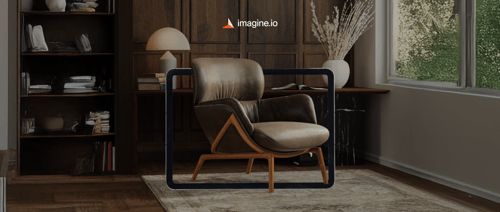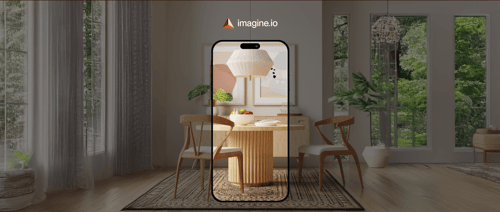The home product industry spanning furniture, textiles, and décor is at a turning point. As eCommerce surges, brands face relentless pressure to deliver visually stunning, interactive experiences that captivate shoppers. From photorealistic imagery to augmented reality (AR) previews, the demand for rich, seamless visuals is reshaping how companies operate. Yet, many are bogged down by a tangle of disconnected tools, agencies, and workflows. A new wave of consolidation is emerging, with platforms like imagine.io leading the charge, helping brands streamline operations, cut costs, and elevate customer engagement across North America.
The Shift to Unified 3D Workflows
Today's home product brands are navigating a perfect storm: ballooning SKU counts, shorter product cycles, and shoppers who expect immersive online experiences. In cities like Austin, New York, and Chicago key hubs for furniture and décor innovation the old approach of cobbling together vendors for photography, CGI, and AR is crumbling. Fragmented systems mean higher costs, longer timelines, and inconsistent visuals that confuse customers across web, social media, and retail platforms.
Enter all-in-one platforms. These solutions, like imagine.io, combine 3D product visualization, product configurators, videos, AR experiences, and virtual showrooms into a single, cloud-based hub. By uploading a 3D model, brands in Dallas or High Point can generate limitless assets lifestyle imagery, 360 spins, or interactive configurators in minutes. This unified approach not only simplifies workflows but also ensures a cohesive brand presence across channels like Instagram, LinkedIn, and YouTube.
Trends Driving 3D Tool Consolidation
From Vendor Chaos to Single Platforms
Historically, brands relied on a patchwork of specialists: one agency for product photography, another for CGI product imagery, and a third for AR viewers. This fractured setup was inefficient and expensive. Now, platforms like imagine.io are consolidating these functions, offering an all-in-one visual platform that handles everything from 3D renders to eCommerce 360 spins. This shift is gaining traction, with the 3D product visualization market valued at $0.34 billion in 2024 and projected to reach $2.95 billion by 2033, growing at a 27.02% CAGR as demand rebounds post-pandemic.
AI and Cloud Rendering: The Game Changers
AI-powered tools and real-time cloud rendering are dismantling traditional barriers. Unlike studio-based workflows that take weeks, cloud platforms deliver photorealistic assets in hours. For brands with high-volume catalogs, this scalability is a lifeline. Imagine a textile company in Los Angeles generating thousands of product images without ballooning costs unlimited renders make it possible.
Consistency Across Omnichannel Experiences
Shoppers don't just browse a brand's website they engage on social platforms, partner sites, and retail marketplaces. Inconsistent visuals erode trust. A unified platform ensures that a sofa looks identical whether viewed on Ruggable's site, a Facebook ad, or a virtual showroom. This cohesion strengthens brand identity and drives engagement across all touchpoints.
Real-World Success: Consolidation in Action
Furniture Leaders Streamline Workflows
Consider a furniture retailer in Las Vegas once juggling multiple vendors for CGI, AR, and product photography. By switching to a single SaaS platform, they slashed production times from weeks to minutes and cut costs by up to 70%. Brands like SertaSimmons and Hunter Fan are seeing similar results, leveraging platforms to produce assets that rival traditional photoshoots. Studies show experts can't distinguish imagine.io's renders from “real” photography, a testament to the technology's quality.
Empowering In-House Teams
Consolidation also frees internal teams from technical burdens. Creative staff at companies like Kohler or Kichler now use drag-and-drop 3D rendering tools to create stunning visuals without specialized skills. This shift lets teams focus on strategy crafting compelling campaigns rather than wrestling with software while maintaining top-tier quality across their catalogs.
Overcoming Consolidation Challenges
Subscription Models vs. Project-Based Work
Not every brand is sold on consolidation. Some prefer the familiarity of project-based agency work over ongoing SaaS subscriptions. Custom pricing, tailored to each client's needs, can also seem complex compared to competitor's flat rates. Yet, the math often favors platforms: a single subscription can replace multiple vendors, delivering unlimited assets for a fraction of the cost.
Onboarding and Learning Curves
Adopting a new platform requires training, which can intimidate teams accustomed to traditional workflows. However, intuitive interfaces and robust support hallmarks of solutions like imagine.io minimize this hurdle. The upfront investment in onboarding pales in comparison to the long-term gains in efficiency and output.
Vendor Lock-In Risks
Some brands worry about over-reliance on a single provider. What if the platform can't evolve with their needs? Flexible subscription models and scalable features mitigate this risk, offering brands the freedom to adapt as their catalogs grow or market demands shift.
Opportunities: Speed, Scale, and Sales
Faster Time-to-Market
In a market where trends change overnight, speed is everything. A décor brand in Canada can go from prototype to online store in hours, not weeks, thanks to real-time rendering. This agility lets companies capitalize on fleeting trends, staying ahead of competitors still mired in slow, fragmented processes.
Boosting eCommerce Conversions
Interactive content AR viewers, 360 spins, and product configurators transforms browsing into buying. A customer exploring a barstool on KegWork's site can spin it in 3D or visualize it in their space via AR, driving engagement and boosting conversions by over 500%. These tools turn passive shoppers into confident purchasers.
Cost Efficiency for Large Catalogs
For brands like Sinomax-USA or KitchenAid, managing thousands of SKUs is a logistical nightmare. Unlimited renders via subscription models eliminate runaway costs, letting companies scale visuals without breaking the bank. As one industry leader noted, “It's like having an in-house studio that never sleeps, producing assets on demand.”
The Future of Platform-Led Visuals
The trajectory is clear: 3D visualization platforms are becoming indispensable. As AI advances, digital assets are matching and sometimes surpassing traditional photography in quality. Integration with eCommerce CMS platforms is simplifying publishing, enabling brands to push visuals directly to sites or partners like PepsiCo or Diageo. The future promises even more: dynamic imagery tailored to individual shoppers, like a virtual showroom where every customer sees a product customized to their preferences.
The 3D visualization market's 27.02% CAGR underscores this shift. As demand rebounds post-pandemic, brands across the U.S. and Canada are embracing platforms that deliver speed, scalability, and innovation.
A New Visual Backbone
Consolidating 3D tools is more than a cost-cutting move it's a strategic overhaul. For furniture, home décor, and textile brands, platforms like imagine.io are redefining how visuals are created and deployed. By blending AI, cloud rendering, and all-in-one functionality, these solutions empower brands to move faster, engage deeper, and scale smarter. In an eCommerce landscape where every pixel matters, those who unify their visual workflows today will shape the future of immersive commerce tomorrow.
Frequently Asked Questions
What are the main benefits of consolidating 3D visualization tools for home product brands?
Consolidating 3D tools offers three key advantages: significant cost reduction (up to 70%), dramatically faster production times (from weeks to minutes), and consistent brand visuals across all channels. By using unified platforms like imagine.io, brands can generate unlimited product renders, AR experiences, and 360-degree spins from a single 3D model, eliminating the need for multiple vendors and fragmented workflows.
How much is the 3D product visualization market expected to grow in the coming years?
The 3D product visualization market is experiencing explosive growth, valued at $0.34 billion in 2024 and projected to reach $2.95 billion by 2033. This represents a compound annual growth rate (CAGR) of 27.02%, driven by post-pandemic demand for immersive online shopping experiences and the increasing adoption of AR and interactive product displays by home furnishing brands.
What challenges do home product brands face when switching from traditional photography to 3D visualization platforms?
The main challenges include adapting to subscription-based pricing models instead of project-based agency work, overcoming learning curves during team onboarding, and concerns about vendor lock-in risks. However, most brands find that intuitive platform interfaces, comprehensive support, and flexible subscription models help minimize these hurdles while delivering long-term efficiency gains and unlimited visual asset generation capabilities.
Disclaimer: The above helpful resources content contains personal opinions and experiences. The information provided is for general knowledge and does not constitute professional advice.
You may also be interested in: Imagine.io | Award Winning 3D + AI Product Visualization
Struggling with expensive, outdated product visuals that slow down your creative process and stunt eCommerce growth? imagine.io's AI-powered platform empowers furniture, home décor, and textile brands to effortlessly produce striking 3D images, immersive videos, AR experiences, and interactive configurators. Cut production costs up to 70%, boost conversions 5X, speed up prototyping, and supercharge your online sales. Ready to elevate your product visuals and captivate customers? Book a demo with imagine.io today!
Powered by flareAI.co




.png?width=500&name=How%20to%20Add%20a%203D%20Product%20Configurator%20to%20Your%20WordPress%20Website%20(Complete%20B2B%20Guide).png)
















%20(1).png?width=500&name=Why%20Exploded%20Mattress%20Views%20Matter%20(And%20How%20to%20Generate%20Them)%20(1).png)
.png?width=500&name=Best%20Shopify%20Product%20Configurator_%20How%20to%20Choose%20the%20Right%20One%20(2).png)
.png?width=500&name=Why%20Exploded%20Mattress%20Views%20Matter%20(And%20How%20to%20Generate%20Them).png)



.png?width=500&name=Best%20Shopify%20Product%20Configurator_%20How%20to%20Choose%20the%20Right%20One%20(1).png)







.png?width=500&name=How%203D%20Rendering%20Can%20Make%20or%20Break%20Your%20Industrial%20Design%20Pitch%20(1).png)








%20with%20Digital%20Twins%20and%203D%20Visualization.png?width=500&name=Optimizing%20Your%20Digital%20Asset%20Management%20(DAM)%20with%20Digital%20Twins%20and%203D%20Visualization.png)




.png?width=500&name=Styling%20Home%20Decor%20for%202025_%20From%20Global%20Influences%20to%20Playful%20Personalization%20(1).png)
